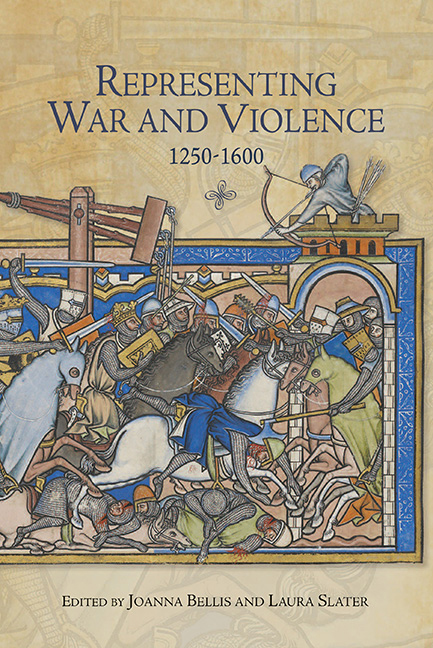Book contents
- Frontmatter
- Contents
- List of Illustrations
- Acknowledgements
- List of Contributors
- Introduction: ‘Representation’ and Medieval Mediations of Violence
- Part I The Ethics and Aesthetics of Depicting War and Violence
- Part II Debating and Narrating Violence
- Part III Experiencing, Representing and Remembering Violence
- Bibliography
- Index
Introduction: ‘Representation’ and Medieval Mediations of Violence
Published online by Cambridge University Press: 05 September 2016
- Frontmatter
- Contents
- List of Illustrations
- Acknowledgements
- List of Contributors
- Introduction: ‘Representation’ and Medieval Mediations of Violence
- Part I The Ethics and Aesthetics of Depicting War and Violence
- Part II Debating and Narrating Violence
- Part III Experiencing, Representing and Remembering Violence
- Bibliography
- Index
Summary
War and violence took many forms in the Middle Ages: territorial conflict (crusade, conquest, civil war); social and judicial actions (joust and tournament, ritual accompaniment to legal action, punitive spectacle, trial by combat or ordeal); spiritual war (diabolical combat, martyrdom, religious persecution, penitential self-mortification, Inquisition); intimate (sexual, domestic, self-inflicted) and comic violence (fabliau, theatre). The media in which violence was attested were similarly polyvalent, from chronicle to romance, hagiography to fabliau, manuscript to fresco. Scholarship has debated the role, motivation and practice of medieval violence at length, from its function as a regulatory civil force to be contained or exploited, to a providentially ordained scourge to be accepted, or an extreme human action to be condemned. Excellent work has also been done on the representation and aesthetics of war and violence.
However, successful attempts to bring the two together have been rarer. This volume offers a new perspective, focused not on medieval violence per se, but its social, artistic and aesthetic treatment, its representation and imagination. The articles in this collection consider the portrayals of historical conflicts alongside more conventionally ‘fictional’ representations (and the slippage between the two), as they ponder the ethical, argumentative and spiritual lenses through which war and violence were scrutinised.
A key contribution of this volume is its interdisciplinary juxtaposition of the perspectives of historians, art historians and literary critics, in discussing how late-medieval writers documented, depicted and narrated the violence of their times. The institutional (and largely artificial) categories of history, history of art and literature operate frequently as active impediments to our understanding of medieval culture. This volume belongs to the wider critical impulse to sustain a methodological conversation that surmounts them. The contributors bring different expectations, priorities and approaches to their material, resulting in a cross-disciplinary dialogue on how we understand this complex topic. This volume aims not only to put the perspectives of these three disciplines side by side, then, but to explore their interpenetrative frontiers. For instance, art-historical analysis of illustrative schemas as paratexts sits alongside literary critical discussion of visualisation as a way of reading; articles by historians ponder the stylistic methods and representational strategies of their primary material, treated as ‘texts’ as well as ‘sources’, while the literary-critical articles ponder the ways in which ‘fictionalising’ the violence of an epic past or a turbulent present served contemporary social and political agendas.
- Type
- Chapter
- Information
- Representing War and Violence, 1250-1600 , pp. 1 - 20Publisher: Boydell & BrewerPrint publication year: 2016



